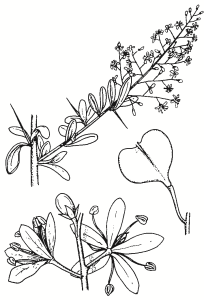Family:
Pittosporaceae
Bursaria spinosa
Hairy Bursaria (subsp. lasiophylla); Sweet Bursaria (subsp. spinosa)
Other Names: Hairy Bursaria, Native Blackthorn, Castanet Bush, Christmas Bush

Name Origin:
Bursaria — from Latin bursa, a purse, referring to pouch-like capsules.
spinosa — from Latin spinosus, thorny, referring to thorny branches.
lasiophylla — from Greek lasios, woolly, and phyllon, leaf, referring to woolly underside of leaf.
Regional Subspecies:
Bursaria spinosa subsp. lasiophylla; B. s. subsp. spinosa
Similar Species:
Distinguish Bursarias by the leaf underside. Hairy Bursaria has downy white leaf underside. Sweet Bursaria leaves green on both surfaces.
Occurrence:
Regional:
Widespread. More common in the higher rainfall areas.
Australia:
NSW, Vic, SA.
Habitat:
Dry sclerophyll forest or woodland, on granite or metamorphic substrates.
Habit:
Shrub to 2.5 m high with clustered green leaves, hairy on underside.
Site Preference:
Well-drained soil. Tolerates frost and wind.
Characteristics:
Long-lived. May be slow-growing.
Flowering:
White to cream — chiefly summer.
Seed Collection:
Late Jan to early May, when ripe fruit rattle. Timing depends on season and location of plants, with seed on plants east of the Hume Highway ripening later than seed on plants further west.
Propagation:
From seed (± 190 viable seeds per gram), and cuttings. Stratifying seed by combining with moist sand and refrigerating for 6 weeks enhances germination. Sow immediately after collection, around Jun-Jul when temperatures low and days short. Germination may take several months. Seedlings prone to late damping-off. Treat with fungicide to reduce losses.
Regeneration:
From seed over winter. Seed dispersed by wind.
VALUES:
Shade & Shelter:
Excellent low-level cover in windbreaks.
Land Protection:
Useful for controlling gully erosion as fibrous roots bind soil.
Wildlife:
Useful habitat as bursaria hosts insects that feed on saw-fly larvae (spit-fire grubs) which feed on eucalypts. Also a nectar source for wasps that parasitise leaf-eating scarab insects and pasture grubs, generally within 200 metres of plants. Fragrant flowers attract butterflies, moths and other native insects. Insect-eating birds attracted. Thorny plants excellent refuge and nest sites for small birds.
Timber:
Timber pale, fine-grained and tough. Seasons well due to little shrinkage. Takes fine polish and has pleasant scent when freshly cut.
Ornamental:
Excellent ornamental or specimens for hedges and cut flowers, due to summer flowering and bronze capsules over winter.
Other:
Leaves contain aesculin, substance thought to absorb ultraviolet rays. European settlers apparently used it to prevent sunburn. There was industry based on collection of leaves for sunburn creams and haemorrhoid treatment. Nectar can be sucked from flowers.
